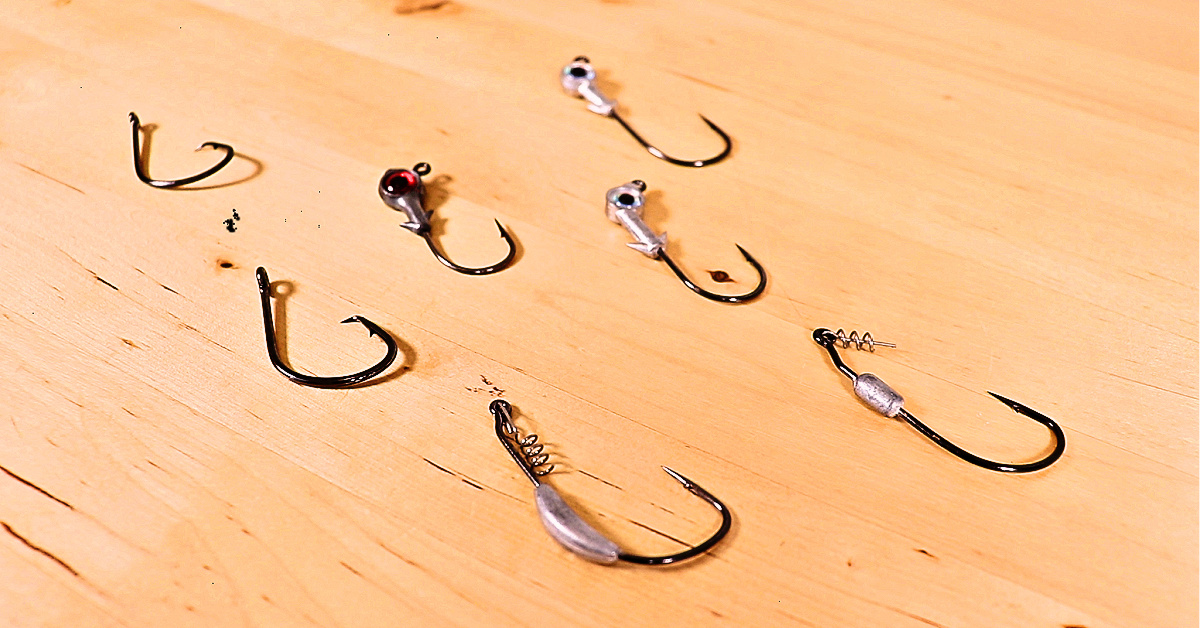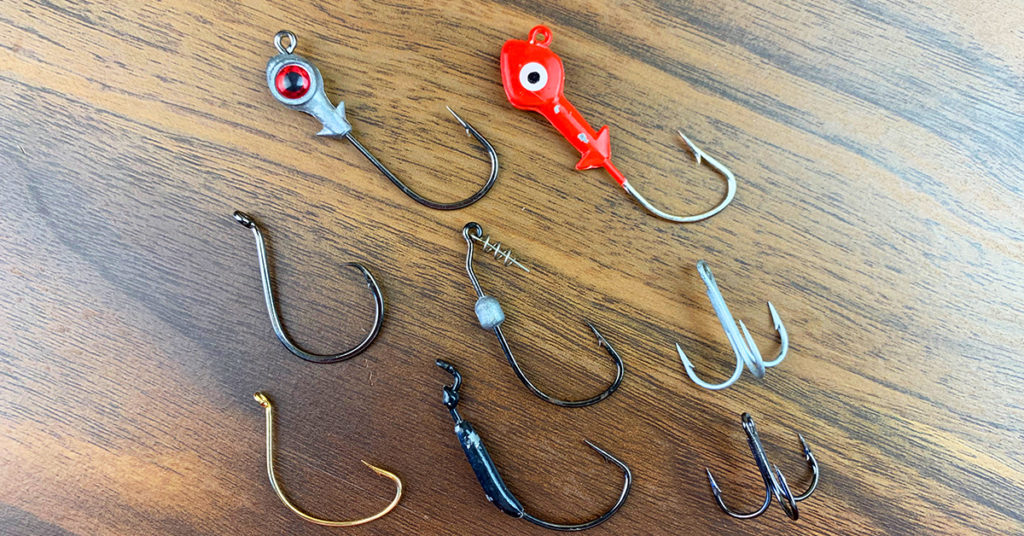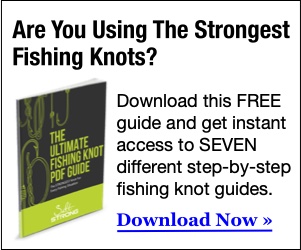The Truth About Hook Sizes (And What You Need To Know)
- By: Tony Acevedo
- on

What are the differences in hook sizes?
Are the numbers used to define hook sizes universally the same for all hook manufacturers?
Hook size has an impact on your lure choice, the species you are targeting, among a plethora of other factors.
Check out more below!!
The Truth About Hook Sizes [VIDEO]

Hook Sizes
Hook sizes range from a size number to an “aught” which represents any hooks that are sized “x/0” with x being a number.
The sizes of hooks range from #1 to #34.
Within that range, the larger the number, the smaller the hook gets.
On the other side of the hook scale, are the “aught” hooks (1/0, 2/0, etc.).
As these numbers get bigger, the hook size increases.
All hook sizes are going to vary depending on the hook manufacturer.
The differences will lie in the length of the hook, hook gap, and hook thickness or gauge.
Hook length is determined by measuring the hook from its eye to the very bottom bend of the hook.
The gap of the hook is the distance between the point and shank of the hook.
Lastly, the hook gauge is decided by the thickness of the hook.
These are all key factors when deciding which hook to use on a specific lure or bait.
A 3/0 hook will be similar from brand to brand but not exact in size.
Hook Thickness
The thickness or gauge of a hook is either light wire gauge or heavy wire gauge.
Thicker or heavy gauge hooks are going to be best used when you are using heavier gear.
If you are fishing around structure and using 20lb+ braided line, then a thicker hook will work best.
You have to put a lot of pressure on those fish to bring them in and you need a hook that will not bend.
The light wire hooks are going to be lighter in weight and are suited for fishing open flats using lighter line.
If you are catching lower to mid-slot size fish, the less thick hooks will get the job done.
When using live bait, the thinner, light wire hooks work better because you aren’t putting a large hole in the bait which avoids the possibility of killing the bait.
Further, the lighter hook allows the live bait to swim around and create more natural action as opposed to a heavier hook.
As a rule of thumb, use thicker hooks for heavier applications and thinner hooks for finesse approaches or fishing with live bait.
Hook Gap
Different hook manufacturers design hooks with slight differences even if they are labeled the same size.
For example, a 3/0 Gamakatsu Weighted Hook has a wider gap than a 3/0 Owner Weighted Twistlock Hook.
The gap of the hook comes into play when choosing a soft plastic lure to pair with a type of hook.
If your soft plastic lure has a larger body, you should choose a hook with a wider hook gap.
The plastic of the lure can actually get in the way of a hookset if the gap of the hook is not wide enough.
If you find yourself losing a lot of fish or missing strikes, it could be because the plastic of the lure is interfering with a hook set.
Since it is not clearly defined in the hook sizes, you have to eyeball the hook gaps of different hooks to choose the best for your specific lure.
Being aware of the differences in hook sizes depending on the manufacturer will set you up for success.
Hook Length
Hook length seems to be more of a factor in different types of jigheads.
Most jighead packaging in stores does not include the length of the hook on the jighead.
Rather, you have to go out and research the length on your own.
There is more focus on the weight of the jighead than the actual length of the hook.
This creates a challenge for anglers when trying to size up soft plastic lures to different jighead hook lengths.
A little cheat you can use is when you are in the tackle store, you can hold up a pack of lures to different jigheads to eyeball if they match up.
The biggest mistake you can make is using a longer hook with a small lure.
In that case, the action of the lure will be off and the presentation will not look natural to a fish.
The hook shank can interfere with the action of a paddletail or prevent a jerk shad from swimming as intended.
A longer hook shank creates a spine in your soft plastic lures that infringes on the lure’s presentation.
On the other hand, you do not want to use a jighead that has too short of a hook shank.
If you rig a longer lure on a short hook shank, you will miss a lot of strikes because that jighead is too far up on the body of the lure.
Remember to keep in mind the size of your soft plastics when matching them to the hook length of a jighead.
Conclusion

Hook sizes vary from hook length, hook gap, as well as hook thickness.
It is important to use the best hook size for your soft plastic lures or live bait to create the best action and presentation.
You will avoid losing fish and enhance the action of your lures or bait by simply using the best hook pairing available.
If you have any further questions on different hook sizes, please ask me down in the comments!




And if you know an angler who wants to learn more about fishing hook sizes, please TAG or SHARE this with them!
P.S. Want access to our best fishing spots and tips, plus discounts to our online tackle store? Click here to join us in the Insider Club
Related articles:
Related categories:
STOP WASTING TIME ON THE WATER!
Do what the “SMART ANGLERS” are doing and join the Insider Club.
Here’s what you’ll receive today when you join:
- Weekly fishing reports and TRENDS revealing exactly where you should fish every trip
- Weekly “spot dissection” videos that walk you through all the best spots in your area
- Exclusive fishing tips from the PROS you can’t find anywhere else
- Everything you need to start catching fish more consistently (regardless if you fish out of a boat, kayak, or land).










Tony, great detailed explanation!
I would also add for jig heads selection… it also depends on the predator species you’re going after “Gulpers” vs “Tailbiters”. For “Gulpers” species such as Stripers, Snook, Redfish, etc. they try to eat the head first so a shorter hook shank would be an advantage. “Tailbiters” such as Bluefish, Flounder, Spanish Mackeral, etc. where they’re going after the tail first a longer hook shank would be an advantage.
Tight Lines
Thank you for the great feedback! Great points!
Nice breakdown Tony !!! One of the things I have run into is when I tie a loop knot on the owner twist lock hook – it sometimes get stuck and does not create the right action. Any help or video reference would be great – thx
Thanks Pablo!
Just make sure when you tie the knot that you don’t accidentally run your line through the actual spring itself. I’ve done that a few times and it will affect the knot. you could also try making the loop a little bigger.
Great explanation knew there was a difference and you clarified it. Thanks Tony
You’re welcome Tom!
Great video, have not seen that explained as well anywhere. The guy that did the hook numbering must have had a few.
Thank you for the great feedback Chris!
Good video, helpful information. Only note is I have yet to find the Gamagatsu hooks you speak of. I have seen many Gamakatsu hooks. Sorry, I couldn’t help myself. Plus, maybe save further embarrassment.
Tomatoe Tomahtoe? Thank you for the feedback David!
Tried to order 6 different items acouple of days ago and they were all out of ststocks? A fungi reel, soft baits, and several owner weighted hooks. Do you know when these items will be back in stock?
Hey Roger!
Getting items in stock has been a headache not just for us but everywhere. The best thing to do is sign up for notifications. Under each item on our shop page you can click the “notify me when available” button. When items are back in stock you will get a notification. I’m right there with ya! I have been using the same 3 owner hooks for months now as I haven’t even been able to get my hands on a pack.